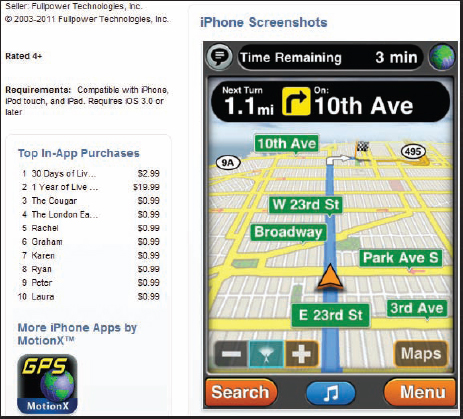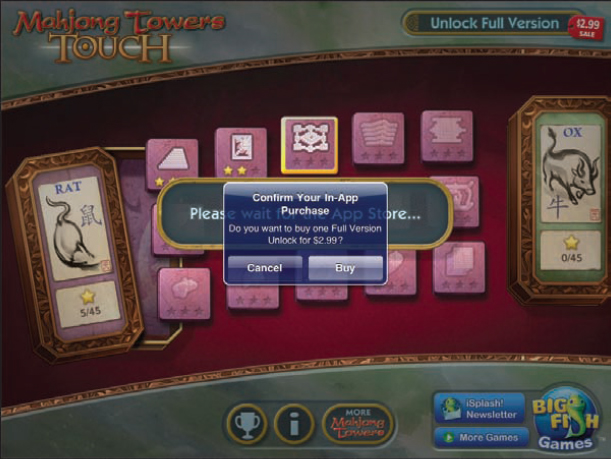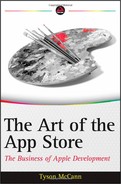APP REVENUE TERMINOLOGY
Just as when any new catchphrase or term begins to spread, some of the terms used in this book regarding the sale of apps may mean different things to different people. For example, what's the difference between a microtransaction and DLC? Or, what does a “Long Tail strategy” mean?
This same phenomenon applied when “Web 2.0” meant a great many things (and still does) to many people when it first appeared. To some, it simply meant anything that was Ajax-coded (that is, neat tricks you could put into websites without a reload). To others, it meant a new way of looking at website design as a simpler, more intuitive user experience (which is what it eventually morphed into).
Terms usually go from meaning specific things to more general definitions. To illuminate this room of indefinite floating terminology in the hopes of providing a better understanding for each term, consider the following short glossary, which, to facilitate easier understanding, is not in alphabetical order.
Microtransaction
A microtransaction is a small purchase in terms of its effect on the game using real money. In most cases, microtransactions are by themselves not critical to your success or enjoyment of the app. But, as a whole, they can offer a few to nearly unlimited ways to customize, enhance, or accelerate your experience. Cost is also irrelevant because it ranges from low to very high.
One example of a microtransaction-based game is “Smurfs' Village” (shown in Figure 7-1), where buying the largest pack of smurfberries (its premium virtual currency) costs about $100, and can be used up by voracious players in a hurry.
In the video game industry, Bethesda infamously released a set of horse armor for its great role-playing game, “Oblivion,” and called it paid DLC (which is discussed next). In this case, though, it was a virtual good meant mostly for appearance, and it was more substantial in that it was released alone (and not with a slew of other downloadable items for the game). Contrast this with some games such as “Farmville” on Facebook (and also on iPhone, but much less played) where there's a zillion premium customization options (which would, in this case, be considered microtransactions). In this case, a distinction is that you don't use real money to purchase any individual microtransaction, but instead “microtransact” the virtual currency.
Downloadable Content (DLC)
Downloadable content (DLC) is featured widely in games as extra, downloadable add-on packs such as levels, bundles of content, or new modes. This is usually distinguished from a microtransaction in that DLC is a one-time, standalone download that may not be built into the app (and, thus, must be downloaded separately). It is also usually downloaded as a supplement to the core program, and, thus, is not unlocked. Finally, DLC typically adds a piece of slightly more substantial content to the experience than would microtransactions, which are usually lumped with one another in groups.

FIGURE 7-1: As a microtransaction example, in “Smurfs' Village,” the cost per microtransaction can be low or very high, which is an example where it's not the size (of the download) that counts
For example, a microtransaction-based system would include large selections of virtual goods that can be bought individually (which, in this case, is almost never classified as DLC). Microtransactions can also include virtual currency that could actually run out (and, thus, be available continuously as an option). Another important distinction is that microtransactions are usually built into the app/game and are, thus, just waiting to be bought or unlocked.
As an example, consider a translation app that offers translation in a few major languages, but then offers Portuguese, Mandarin, and so on as paid DLC options for those who would use them. Most users would probably need only one or two. If you're the developer, you're not going to offer all these packs bundled into the initial download or for free, of course, and, therefore, you offer them as paid DLC, each with its own separate download.
Another example would be a GPS app (such as the one shown in Figure 7-2) that offers paid DLC packs of different voices for the navigator.
In essence, the core difference between DLC and microtransactions is that, with DLC, the content is not already a part of the app, and must be downloaded separately. Hence, it can add to the experience, but is not already a part of the core experience.

FIGURE 7-2: In this GPS app by MotionX, DLC is indistinguishable from microtransactions
Free App
A purely free app is just that. There are no strings attached for the user, if you don't count the likelihood of being upsold or cross-sold other items, or having the occasional ad interrupt your experience. If a free app offers microtransactions or DLC to enhance or extend the experience, then, for all intents and purposes, it is called “freemium.”
Freemium App
Freemium is a combination of “free” and “premium.” Although the model is not, the term is relatively new, and is synonymous with “free-to-play” when referring to games. This app will always be free to try or download, but users can opt in with real money for premium content, features, or other items, whether via subscription, microtransaction, or, for the purposes of this book, DLC.
So, could DLC be considered freemium when caged within a free app?
Some app developers with separate, paid DLC refer to their apps as freemium when, in fact, traditionally this would not be the case. Until now, freemium has meant that you have content that must be unlocked via payment or microtransaction, not an optional download.
However, these developers may eventually get their way, because there really is no term yet for a free app that offers separate DLC, and freemium should work just as well for those — as in the generic free app that offers additional paid options. Therefore, this book will also adopt the term “freemium” to include free apps with separate paid DLC options.
In-App Purchase
An in-app purchase is anything users can purchase while staying within the app, usually after entering their Apple passwords. This can be anything from a microtransaction, to unlocking new features (or removing unwanted features such as ads), to purchasing a subscription to DLC. Note that in-app purchases can be turned off in any i-device's settings, but to the developer's benefit, users will still be allowed to see and attempt to purchase, before getting a notification that the setting is turned off.
Free-to-Play App (F2P)
Mostly used when referring to games, a free-to-play (F2P) app is synonymous with “freemium.” The “free” part means that only some of it is free. Otherwise, it would just be simply “free” and not free-to-play (that is, a marketing creation).
Lite App
A lite app is a restricted version of a paid app (either in terms of content, or in some other way) that, once bought, removes any such restrictions. Lite versions often include cleverly placed screens and other links to a paid and unrestricted version of the same app. Traditionally, tapping one of these links would take you to the App Store. In that case, this would not be a microtransaction or in-app purchase, but a direct download of the paid version.
However, apps are migrating to a new method — that of actually building this in as an in-app purchase. A current game that was rated Number 1 for the iPad, in fact, does this — “Mahjong Towers Touch HD,” shown Figure 7-3.

FIGURE 7-3: “Mahjong Towers Touch HD” uses the in-app purchase for unlocking the full version
Long Tail Strategy
The term “Long Tail” gained popularity in a 2004 Wired magazine article by Chris Anderson, where he mentioned its use by Amazon and Netflix. Anderson later wrote a more in-depth book called The Long Tail: Why the Future of Business is Selling Less for More (New York: Hyperion, 2006).
Long Tail means that a larger percentage of people will buy lots of different items than will buy a small number of popular items. This is made possible in part by the capability on the Internet to “stock” unlimited items, and the capability for fulfillment companies to be able to manage it.
Now that you understand these core terms, it will be easier for you to understand some of the business reasons for favoring a particular type of app, and then later the art of selling them.
